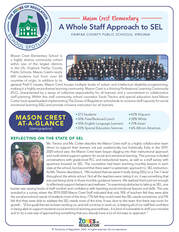Our Zones of Regulation School Spotlight series highlights schools and districts using The Zones to make a positive impact in their learning community. For this Spotlight, we headed to Fairfax County, Virginia.

Mason Crest Elementary School is a highly diverse community school within one of the largest districts in the US, Virginia’s Fairfax County Public Schools. Mason Crest’s nearly 600 students hail from over 60 countries of origin. In addition to its general PreK-5 classes, Mason Crest houses multiple levels of autism and intellectual disability programming, making it a highly neurodiverse learning community.
Mason Crest is a thriving Professional Learning Community (PLC), characterized by a sense of collective responsibility for all learners and a commitment to collaborative staff planning. Within this staff community, school counselor Sarah Trevino and special education lead Maura Cotter have spearheaded implementing The Zones of Regulation schoolwide to increase staff capacity for social emotional learning (SEL) and provide inclusive instruction for all learners.

REFLECTING ON THE STATE OF SEL

Ms. Trevino and Ms. Cotter describe the Mason Crest staff as a highly collaborative team driven to support their learners not just academically, but holistically. Early in the 2019-2020 school year, the Mason Crest team began digging into their instructional approach and multi-tiered support systems for social and emotional learning. This process included conversations with grade-level PLC and instructional teams, as well as a staff survey with questions focused on SEL.
The counselors had been teaching monthly lessons in each class at the school, but beyond that there wasn’t a systematic approach to SEL instruction. As Ms. Trevino describes it, “We realized that we weren’t really doing [SEL] on a Tier-1 level throughout the whole school. Not all the teachers were taking it on, it was something that was just being done in those monthly guidance lessons. We realized that’s just not enough to effectively support behavior and wellness.”
In examining obstacles to taking on SEL, one barrier was varying levels of staff comfort and confidence with teaching social emotional lessons and skills. This was revealed in a survey where the 2019-2020 Mason Crest Staff indicated that only 18% of teachers felt they were able the social emotional needs of students most of the time, 77% felt they could meet the SEL needs sometimes, and 5% felt that they were able to address the SEL needs none of the time. It was clear to the team that there was room for growth. “[One goal] that we’ve been working on, and will continue to work on, is helping all of our staff feel confident in being able to support students social emotional learning and wellness…It is kind of vulnerable to shift your mindset and to try a new way of approaching something that you already have a lot of old ways to approach.”
THE IMPLEMENTATION PROCESS
The Mason Crest team rolled up their sleeves and began a multi-year SEL implementation process starting with monthly grade-level PLC meetings focused on SEL needs and supports. During these monthly meetings, the 5th grade team in particular noticed that their students were struggling to identify and manage emotions, resulting in a lot of classroom disruptions. The Zones of Regulation was already being taught in Mason Crest’s special education programs and the 5th grade team wondered if The Zones lessons could address the skills they were looking to support. They piloted Zones lessons using a co-teaching model, and the implementation was so successful that they decided to roll it out with all grades the following year. What no one saw coming was Covid-19.
The immediate need for a systematic approach to SEL became increasingly urgent when the school shut down due to the onset of the pandemic. “We were getting a lot of feedback from families saying ‘My kid is not doing okay.’ ‘They’re very emotional, their feelings are very big.’ ‘What do we do?’” In response, the Mason Crest team got together during the summer to work on a whole school SEL roll-out for the Fall. They created an overarching schoolwide implementation plan using The Zones of Regulation including monthly grade level PLC meetings to plan the specific lessons taught in Morning Meetings. As a part of this work they integrated The Zones into their existing Responsive Classroom structure, and used the common language of The Zones to tie together other SEL practices used across grade levels and programs.
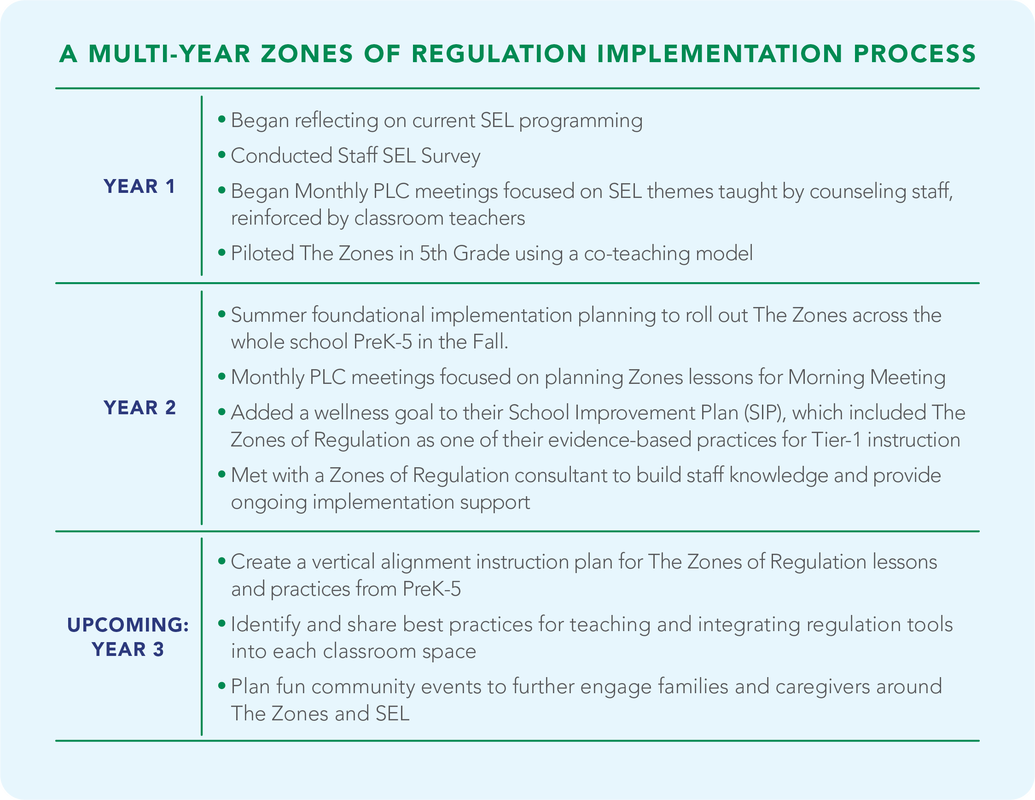
Ms. Trevino and Ms. Cotter both noted that a significant part of why The Zones of Regulation was selected, and ultimately so successful, is that it is accessible for all of their learners, from their Pre-K program through 5th grade, English Language Learners, and special education programming. The staff and students built a common language using The Zones that has served as a foundation for a climate that supports student wellness across the school.
The Zones of Regulation is so user-friendly. It builds such a common vocabulary that both captures the intricacies of emotion and emotional regulation, but in a way that is easy to access for some of our language learners and our kids who are building vocabulary [as well as with kids] with some of those tools already in their toolbox.
INTEGRATING THE ZONES INTO THE SCHOOL DAY
The Zones language and practices have become part of the fabric of Mason Crest. Beyond morning meeting lessons, Mason Crest teachers are referring to The Zones throughout the day, and creating spaces for students to access regulation tools. You will often hear teachers using Zones language in their literature discussions, such as “What Zone do you think this character is in? How do you know?” Teachers have also begun to integrate times for everyone to pause and Check-In with Zones throughout the school day. They use these Zones Check-ins as an opportunity for students to practice self-awareness, take a mindful moment, and build a climate of connection.
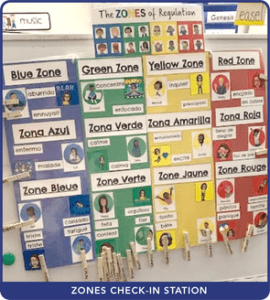
Ms. Cotter describes how well these Check-ins have been integrated into the daily routine: “I was in 1st grade for a lesson… and they were coming in from recess. Their teacher has a [Zones] check-in station where they have their name and [move them between] the different Zones throughout the day. Probably 2 or 3 months ago when I was in there for a lesson, the teacher had come in and said, ‘Okay, everybody do a Zones check-in’, and they would all go through and do their check… Well, today I was in there and the teacher said nothing. [The students] came in and some of them sat down, some got water, some of them went over and changed their Zone clip from where they were. There was no conversation about it, it was just really organic that the students were reflecting ‘Do I need to change which Zone I’m in or not?… The teacher was also paying attention so she could be responsive.” By setting up systems around The Zones such as a Check-in routine, this teacher, and others at Mason Crest are helping students gain independence and efficacy in taking care of their wellness at school.
IMPACTS AND OUTCOMES
The Zones of Regulation has had a positive impact on student SEL skills and overall school climate from all corners of the school- Pre K and Special Education programming through 5th grade. They attribute part of this impact to the unique way The Zones is accessible to learners of all ages and abilities. Ms. Trevino has seen a shift in the number of students needing to leave the classroom to access regulation support in the counseling office. “A lot of times our students who were really struggling with emotional regulation … were ending up with me, or ending up in the hallway and really struggling to be able to get back and ready to learn. We’ve certainly seen a decrease in students who end up really stuck in the Yellow and Red Zones and unable to re-enter the classroom.”
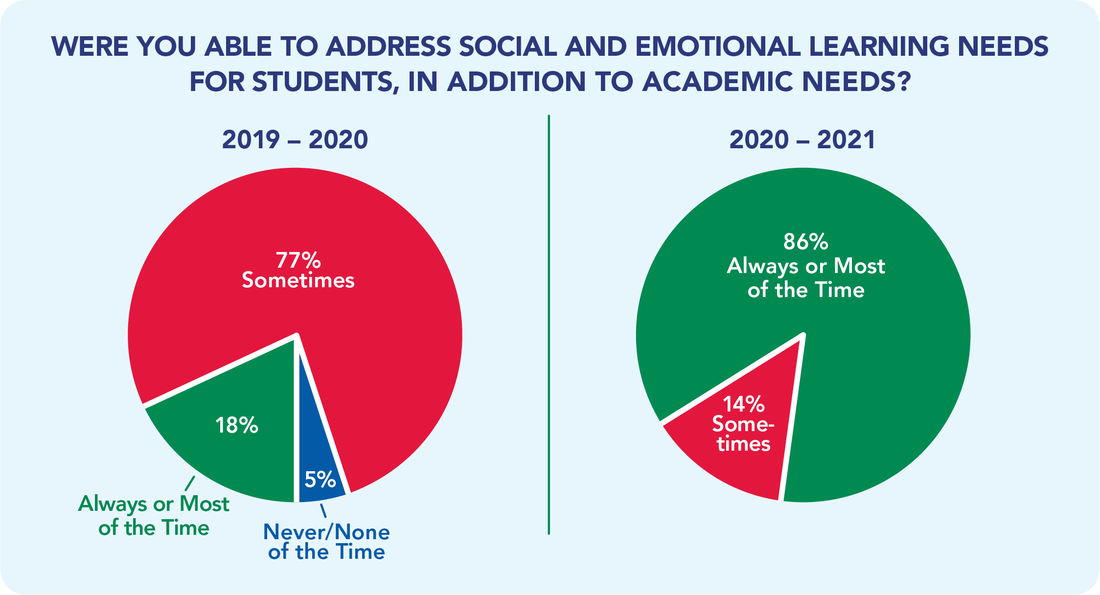
Through their collaborative approach, the staff at Mason Crest feel they have made significant progress toward teaching and supporting SEL. At the end of their first year of implementing The Zones as Tier-1 instruction across the school, the teachers’ response to the question, “Were you able to address social and emotional learning needs for students, in addition to academic needs?” “Always” or “Most of the Time” increased from 18% to 86% percent from the year before! Ms. Trevino explains, “Whereas [students] would always be coming out of the room if they were crying and upset to see me, their teachers are now feeling confident to be able to give their students tools within the classroom.”
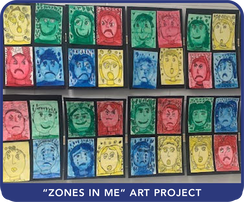
The Mason Crest team is hard at work planning for their students to come back in the fall. We look forward to hearing how the upcoming school year unfolds for the dedicated Mason Crest staff and their students!
